Commonwealth Bank of Australia: Innovation for Sustainable Development
VerifiedAdded on 2023/06/12
|9
|2324
|484
Essay
AI Summary
This essay provides an overview of the importance of business innovation and the application of the business model canvas for sustainable development, focusing on the Commonwealth Bank of Australia (CBA). It discusses how a business model can help organizations like CBA maintain strategic decisions, improve operations, and align decisions with company objectives. The essay explores the disruptive technique for reforming business structures and functions, emphasizing the role of technology in driving changes. It suggests that CBA can adopt smart connected products to enhance its business activities and maintain flexibility. The analysis also considers the potential threats associated with these changes, such as technical faults and employee resistance, highlighting the importance of a business model canvas to mitigate these risks. The essay concludes that CBA should embrace innovation to maintain its competitive edge and expand its services beyond Australia and New Zealand, ensuring customer satisfaction through high-quality services and flexibility.
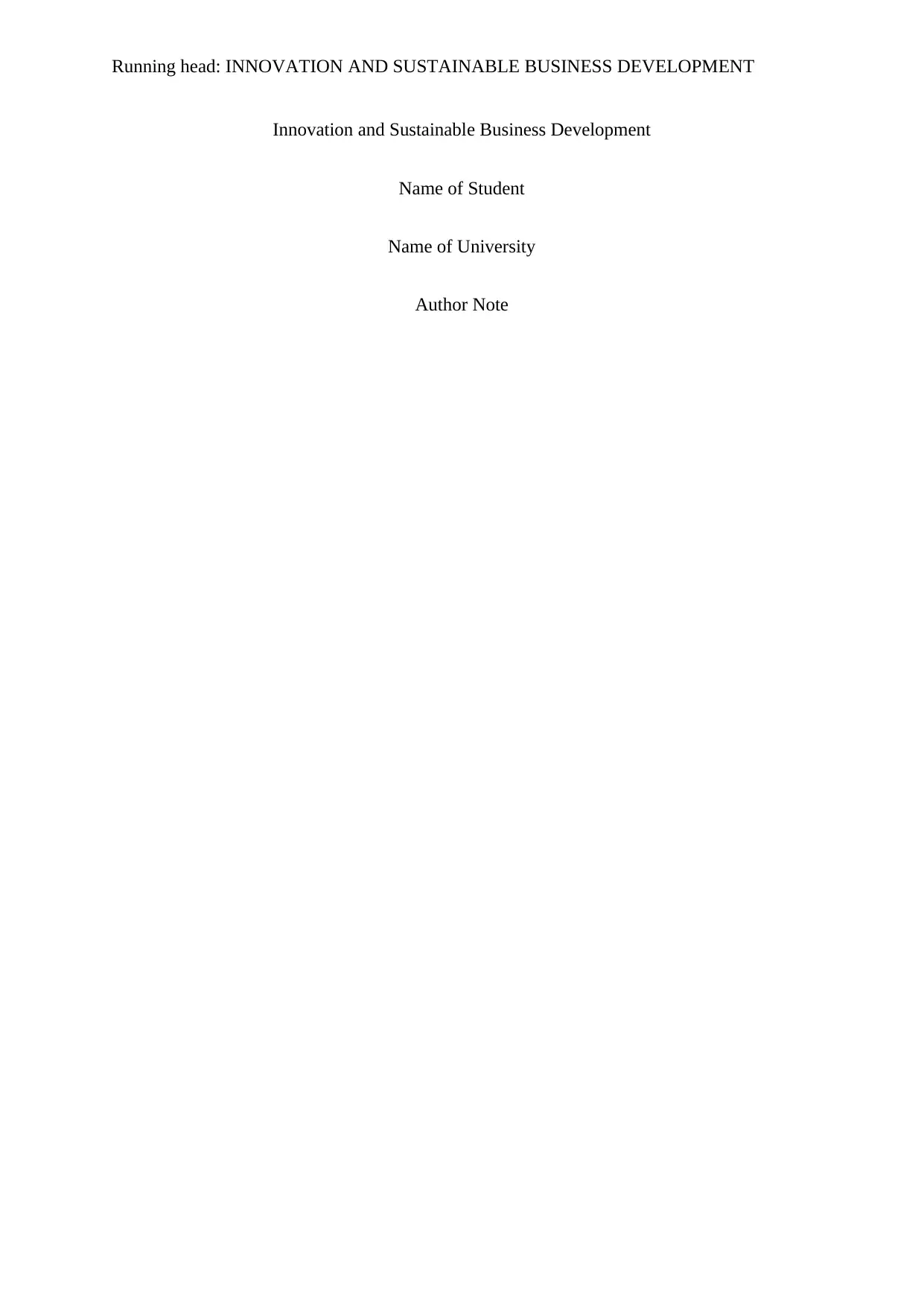
Running head: INNOVATION AND SUSTAINABLE BUSINESS DEVELOPMENT
Innovation and Sustainable Business Development
Name of Student
Name of University
Author Note
Innovation and Sustainable Business Development
Name of Student
Name of University
Author Note
Paraphrase This Document
Need a fresh take? Get an instant paraphrase of this document with our AI Paraphraser
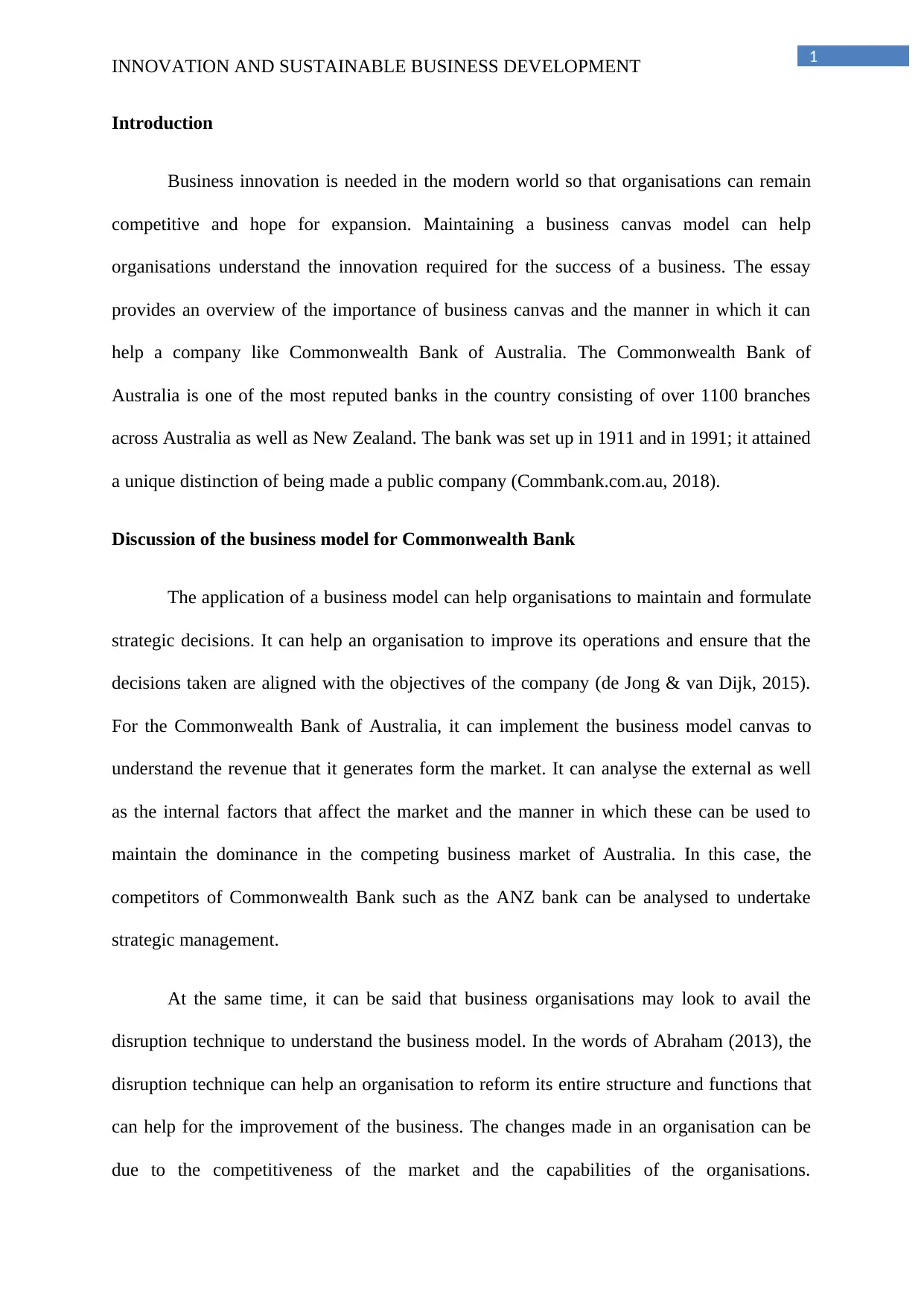
1
INNOVATION AND SUSTAINABLE BUSINESS DEVELOPMENT
Introduction
Business innovation is needed in the modern world so that organisations can remain
competitive and hope for expansion. Maintaining a business canvas model can help
organisations understand the innovation required for the success of a business. The essay
provides an overview of the importance of business canvas and the manner in which it can
help a company like Commonwealth Bank of Australia. The Commonwealth Bank of
Australia is one of the most reputed banks in the country consisting of over 1100 branches
across Australia as well as New Zealand. The bank was set up in 1911 and in 1991; it attained
a unique distinction of being made a public company (Commbank.com.au, 2018).
Discussion of the business model for Commonwealth Bank
The application of a business model can help organisations to maintain and formulate
strategic decisions. It can help an organisation to improve its operations and ensure that the
decisions taken are aligned with the objectives of the company (de Jong & van Dijk, 2015).
For the Commonwealth Bank of Australia, it can implement the business model canvas to
understand the revenue that it generates form the market. It can analyse the external as well
as the internal factors that affect the market and the manner in which these can be used to
maintain the dominance in the competing business market of Australia. In this case, the
competitors of Commonwealth Bank such as the ANZ bank can be analysed to undertake
strategic management.
At the same time, it can be said that business organisations may look to avail the
disruption technique to understand the business model. In the words of Abraham (2013), the
disruption technique can help an organisation to reform its entire structure and functions that
can help for the improvement of the business. The changes made in an organisation can be
due to the competitiveness of the market and the capabilities of the organisations.
INNOVATION AND SUSTAINABLE BUSINESS DEVELOPMENT
Introduction
Business innovation is needed in the modern world so that organisations can remain
competitive and hope for expansion. Maintaining a business canvas model can help
organisations understand the innovation required for the success of a business. The essay
provides an overview of the importance of business canvas and the manner in which it can
help a company like Commonwealth Bank of Australia. The Commonwealth Bank of
Australia is one of the most reputed banks in the country consisting of over 1100 branches
across Australia as well as New Zealand. The bank was set up in 1911 and in 1991; it attained
a unique distinction of being made a public company (Commbank.com.au, 2018).
Discussion of the business model for Commonwealth Bank
The application of a business model can help organisations to maintain and formulate
strategic decisions. It can help an organisation to improve its operations and ensure that the
decisions taken are aligned with the objectives of the company (de Jong & van Dijk, 2015).
For the Commonwealth Bank of Australia, it can implement the business model canvas to
understand the revenue that it generates form the market. It can analyse the external as well
as the internal factors that affect the market and the manner in which these can be used to
maintain the dominance in the competing business market of Australia. In this case, the
competitors of Commonwealth Bank such as the ANZ bank can be analysed to undertake
strategic management.
At the same time, it can be said that business organisations may look to avail the
disruption technique to understand the business model. In the words of Abraham (2013), the
disruption technique can help an organisation to reform its entire structure and functions that
can help for the improvement of the business. The changes made in an organisation can be
due to the competitiveness of the market and the capabilities of the organisations.
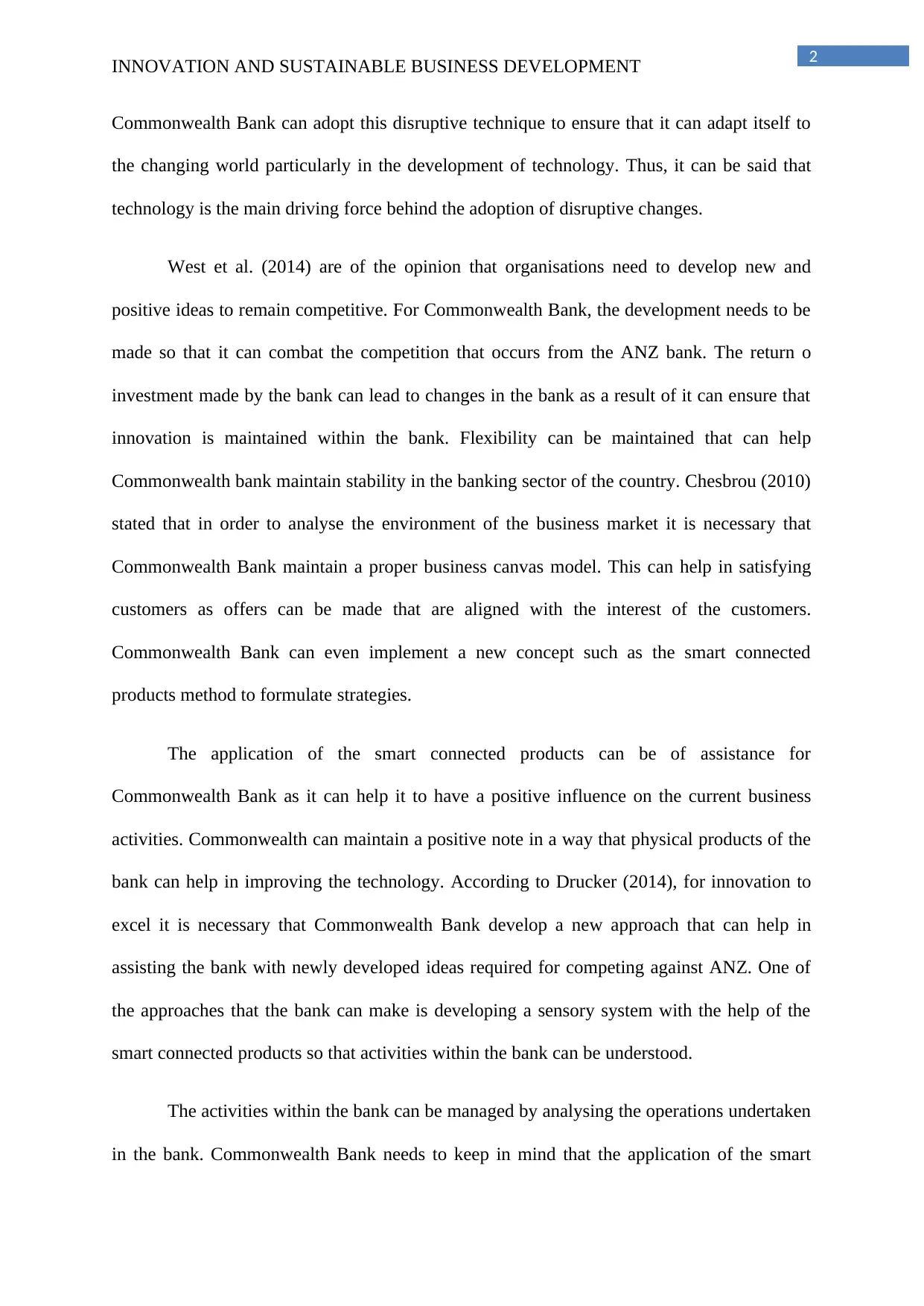
2
INNOVATION AND SUSTAINABLE BUSINESS DEVELOPMENT
Commonwealth Bank can adopt this disruptive technique to ensure that it can adapt itself to
the changing world particularly in the development of technology. Thus, it can be said that
technology is the main driving force behind the adoption of disruptive changes.
West et al. (2014) are of the opinion that organisations need to develop new and
positive ideas to remain competitive. For Commonwealth Bank, the development needs to be
made so that it can combat the competition that occurs from the ANZ bank. The return o
investment made by the bank can lead to changes in the bank as a result of it can ensure that
innovation is maintained within the bank. Flexibility can be maintained that can help
Commonwealth bank maintain stability in the banking sector of the country. Chesbrou (2010)
stated that in order to analyse the environment of the business market it is necessary that
Commonwealth Bank maintain a proper business canvas model. This can help in satisfying
customers as offers can be made that are aligned with the interest of the customers.
Commonwealth Bank can even implement a new concept such as the smart connected
products method to formulate strategies.
The application of the smart connected products can be of assistance for
Commonwealth Bank as it can help it to have a positive influence on the current business
activities. Commonwealth can maintain a positive note in a way that physical products of the
bank can help in improving the technology. According to Drucker (2014), for innovation to
excel it is necessary that Commonwealth Bank develop a new approach that can help in
assisting the bank with newly developed ideas required for competing against ANZ. One of
the approaches that the bank can make is developing a sensory system with the help of the
smart connected products so that activities within the bank can be understood.
The activities within the bank can be managed by analysing the operations undertaken
in the bank. Commonwealth Bank needs to keep in mind that the application of the smart
INNOVATION AND SUSTAINABLE BUSINESS DEVELOPMENT
Commonwealth Bank can adopt this disruptive technique to ensure that it can adapt itself to
the changing world particularly in the development of technology. Thus, it can be said that
technology is the main driving force behind the adoption of disruptive changes.
West et al. (2014) are of the opinion that organisations need to develop new and
positive ideas to remain competitive. For Commonwealth Bank, the development needs to be
made so that it can combat the competition that occurs from the ANZ bank. The return o
investment made by the bank can lead to changes in the bank as a result of it can ensure that
innovation is maintained within the bank. Flexibility can be maintained that can help
Commonwealth bank maintain stability in the banking sector of the country. Chesbrou (2010)
stated that in order to analyse the environment of the business market it is necessary that
Commonwealth Bank maintain a proper business canvas model. This can help in satisfying
customers as offers can be made that are aligned with the interest of the customers.
Commonwealth Bank can even implement a new concept such as the smart connected
products method to formulate strategies.
The application of the smart connected products can be of assistance for
Commonwealth Bank as it can help it to have a positive influence on the current business
activities. Commonwealth can maintain a positive note in a way that physical products of the
bank can help in improving the technology. According to Drucker (2014), for innovation to
excel it is necessary that Commonwealth Bank develop a new approach that can help in
assisting the bank with newly developed ideas required for competing against ANZ. One of
the approaches that the bank can make is developing a sensory system with the help of the
smart connected products so that activities within the bank can be understood.
The activities within the bank can be managed by analysing the operations undertaken
in the bank. Commonwealth Bank needs to keep in mind that the application of the smart
⊘ This is a preview!⊘
Do you want full access?
Subscribe today to unlock all pages.

Trusted by 1+ million students worldwide

3
INNOVATION AND SUSTAINABLE BUSINESS DEVELOPMENT
connected products can help the bank to remain flexible as well as streamline the applications
with the computer system (Euchner, 2016). The streamlining system is usually utilised by
banks so that Commonwealth Bank can make improvement in the existing business model
that the company uses. Commonwealth Bank can gain opportunities for expansion in the
international market and hope to continue its dominance in the banking sector. Johnson,
Christensen and Kagermann (2008) are of the opinion that the profitability of the company
can be determined by the involvement of the stakeholders. However, along with the
opportunities, the threats of using the smart connected products need to be analysed.
It can be said that the opportunities that can be obtained by Commonwealth Bank for
its development in the Australian market can be related to the success factor of the bank.
Commonwealth Bank needs to use the opportunities provided to them by mitigating the
threats that may arise. These threats can be in the form of internal capabilities or the external
competitive threats of the company. De Reuver, Bouwman and Haaker (2013) stated that the
application of the smart connected products might instigate changes in the services of the
company. One of the reasons for the increased reputation of Commonwealth is the fact that it
provides good quality services to the people. Hence, it is necessary that such service is
maintained despite the changes adopted for the betterment of the organisation.
Porter and Heppelmann (2014) stated that the application of smart connected products
might lead to technical faults. The faults in the technical aspect of a company can be
considered as a huge disadvantage particularly in the era in which technology is the main
source of support. For Commonwealth Bank, the company may face stiff challenges in
coping up with the competitive nature of the business. These faults can occur mainly because
the system of the company has not been tested before implementation. At the same time, the
employees may not accept the rapid changes in the companies. This is because of the fact that
the changes require disruption in the workforce and workability of the employees. Hence,
INNOVATION AND SUSTAINABLE BUSINESS DEVELOPMENT
connected products can help the bank to remain flexible as well as streamline the applications
with the computer system (Euchner, 2016). The streamlining system is usually utilised by
banks so that Commonwealth Bank can make improvement in the existing business model
that the company uses. Commonwealth Bank can gain opportunities for expansion in the
international market and hope to continue its dominance in the banking sector. Johnson,
Christensen and Kagermann (2008) are of the opinion that the profitability of the company
can be determined by the involvement of the stakeholders. However, along with the
opportunities, the threats of using the smart connected products need to be analysed.
It can be said that the opportunities that can be obtained by Commonwealth Bank for
its development in the Australian market can be related to the success factor of the bank.
Commonwealth Bank needs to use the opportunities provided to them by mitigating the
threats that may arise. These threats can be in the form of internal capabilities or the external
competitive threats of the company. De Reuver, Bouwman and Haaker (2013) stated that the
application of the smart connected products might instigate changes in the services of the
company. One of the reasons for the increased reputation of Commonwealth is the fact that it
provides good quality services to the people. Hence, it is necessary that such service is
maintained despite the changes adopted for the betterment of the organisation.
Porter and Heppelmann (2014) stated that the application of smart connected products
might lead to technical faults. The faults in the technical aspect of a company can be
considered as a huge disadvantage particularly in the era in which technology is the main
source of support. For Commonwealth Bank, the company may face stiff challenges in
coping up with the competitive nature of the business. These faults can occur mainly because
the system of the company has not been tested before implementation. At the same time, the
employees may not accept the rapid changes in the companies. This is because of the fact that
the changes require disruption in the workforce and workability of the employees. Hence,
Paraphrase This Document
Need a fresh take? Get an instant paraphrase of this document with our AI Paraphraser
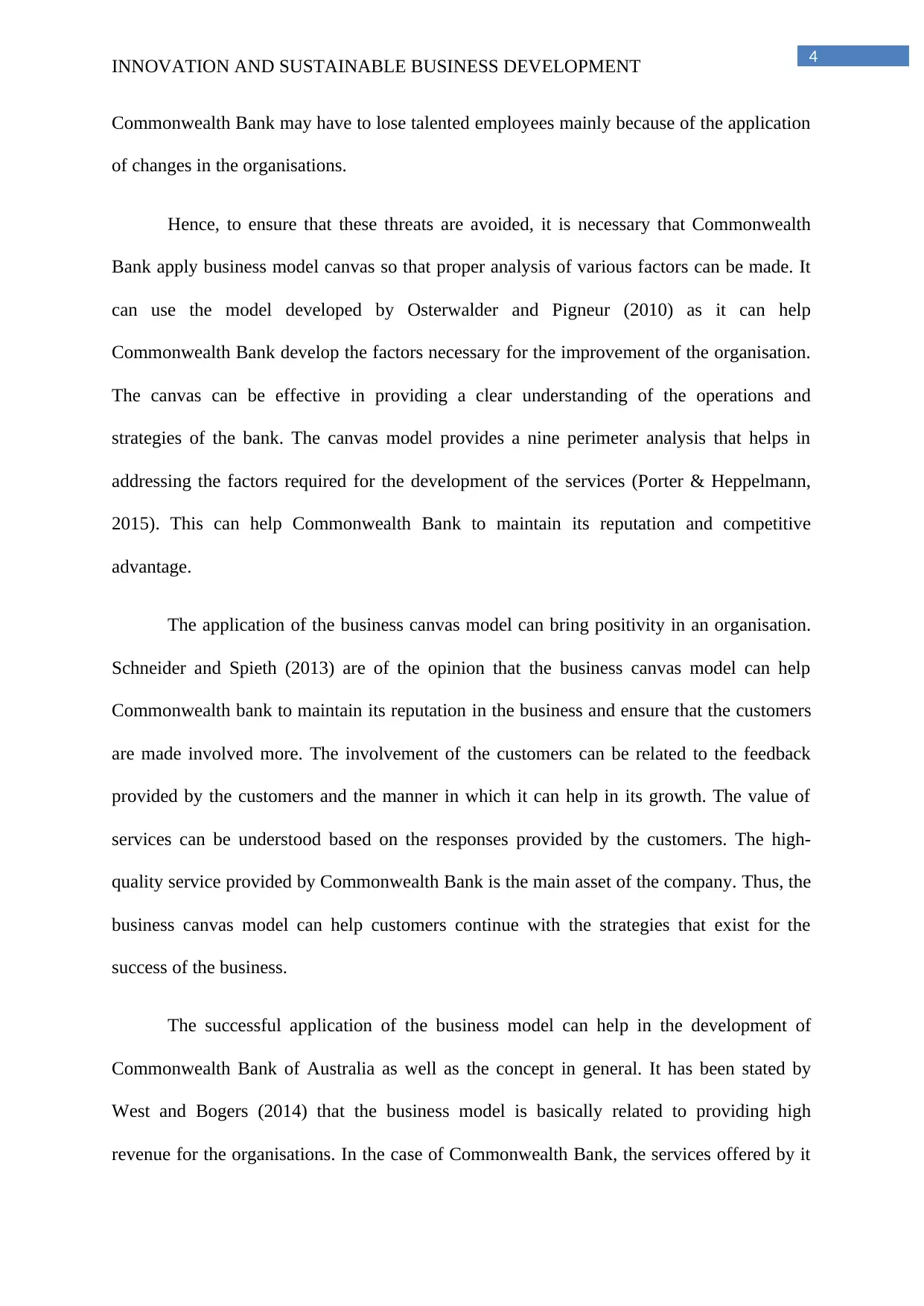
4
INNOVATION AND SUSTAINABLE BUSINESS DEVELOPMENT
Commonwealth Bank may have to lose talented employees mainly because of the application
of changes in the organisations.
Hence, to ensure that these threats are avoided, it is necessary that Commonwealth
Bank apply business model canvas so that proper analysis of various factors can be made. It
can use the model developed by Osterwalder and Pigneur (2010) as it can help
Commonwealth Bank develop the factors necessary for the improvement of the organisation.
The canvas can be effective in providing a clear understanding of the operations and
strategies of the bank. The canvas model provides a nine perimeter analysis that helps in
addressing the factors required for the development of the services (Porter & Heppelmann,
2015). This can help Commonwealth Bank to maintain its reputation and competitive
advantage.
The application of the business canvas model can bring positivity in an organisation.
Schneider and Spieth (2013) are of the opinion that the business canvas model can help
Commonwealth bank to maintain its reputation in the business and ensure that the customers
are made involved more. The involvement of the customers can be related to the feedback
provided by the customers and the manner in which it can help in its growth. The value of
services can be understood based on the responses provided by the customers. The high-
quality service provided by Commonwealth Bank is the main asset of the company. Thus, the
business canvas model can help customers continue with the strategies that exist for the
success of the business.
The successful application of the business model can help in the development of
Commonwealth Bank of Australia as well as the concept in general. It has been stated by
West and Bogers (2014) that the business model is basically related to providing high
revenue for the organisations. In the case of Commonwealth Bank, the services offered by it
INNOVATION AND SUSTAINABLE BUSINESS DEVELOPMENT
Commonwealth Bank may have to lose talented employees mainly because of the application
of changes in the organisations.
Hence, to ensure that these threats are avoided, it is necessary that Commonwealth
Bank apply business model canvas so that proper analysis of various factors can be made. It
can use the model developed by Osterwalder and Pigneur (2010) as it can help
Commonwealth Bank develop the factors necessary for the improvement of the organisation.
The canvas can be effective in providing a clear understanding of the operations and
strategies of the bank. The canvas model provides a nine perimeter analysis that helps in
addressing the factors required for the development of the services (Porter & Heppelmann,
2015). This can help Commonwealth Bank to maintain its reputation and competitive
advantage.
The application of the business canvas model can bring positivity in an organisation.
Schneider and Spieth (2013) are of the opinion that the business canvas model can help
Commonwealth bank to maintain its reputation in the business and ensure that the customers
are made involved more. The involvement of the customers can be related to the feedback
provided by the customers and the manner in which it can help in its growth. The value of
services can be understood based on the responses provided by the customers. The high-
quality service provided by Commonwealth Bank is the main asset of the company. Thus, the
business canvas model can help customers continue with the strategies that exist for the
success of the business.
The successful application of the business model can help in the development of
Commonwealth Bank of Australia as well as the concept in general. It has been stated by
West and Bogers (2014) that the business model is basically related to providing high
revenue for the organisations. In the case of Commonwealth Bank, the services offered by it
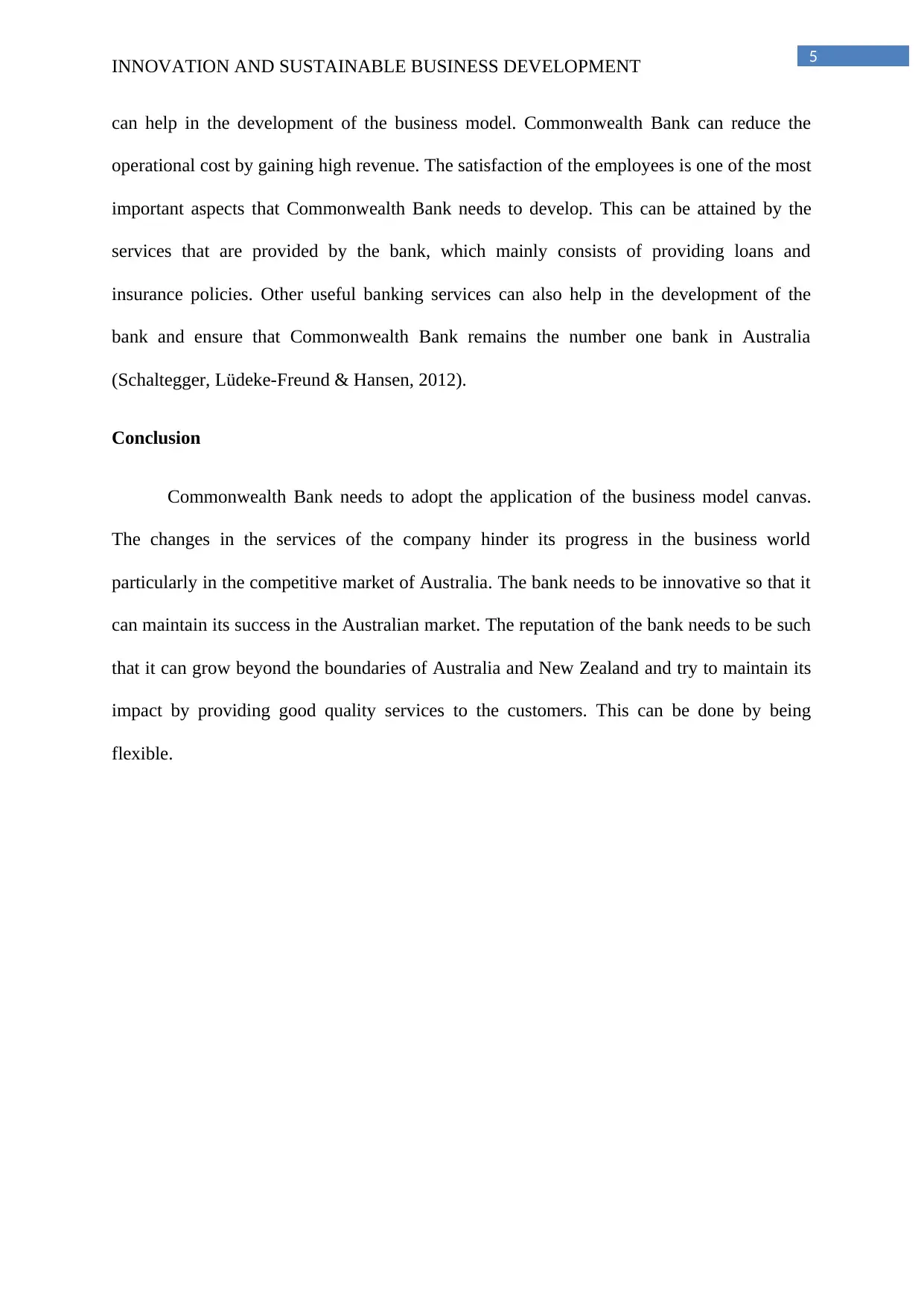
5
INNOVATION AND SUSTAINABLE BUSINESS DEVELOPMENT
can help in the development of the business model. Commonwealth Bank can reduce the
operational cost by gaining high revenue. The satisfaction of the employees is one of the most
important aspects that Commonwealth Bank needs to develop. This can be attained by the
services that are provided by the bank, which mainly consists of providing loans and
insurance policies. Other useful banking services can also help in the development of the
bank and ensure that Commonwealth Bank remains the number one bank in Australia
(Schaltegger, Lüdeke-Freund & Hansen, 2012).
Conclusion
Commonwealth Bank needs to adopt the application of the business model canvas.
The changes in the services of the company hinder its progress in the business world
particularly in the competitive market of Australia. The bank needs to be innovative so that it
can maintain its success in the Australian market. The reputation of the bank needs to be such
that it can grow beyond the boundaries of Australia and New Zealand and try to maintain its
impact by providing good quality services to the customers. This can be done by being
flexible.
INNOVATION AND SUSTAINABLE BUSINESS DEVELOPMENT
can help in the development of the business model. Commonwealth Bank can reduce the
operational cost by gaining high revenue. The satisfaction of the employees is one of the most
important aspects that Commonwealth Bank needs to develop. This can be attained by the
services that are provided by the bank, which mainly consists of providing loans and
insurance policies. Other useful banking services can also help in the development of the
bank and ensure that Commonwealth Bank remains the number one bank in Australia
(Schaltegger, Lüdeke-Freund & Hansen, 2012).
Conclusion
Commonwealth Bank needs to adopt the application of the business model canvas.
The changes in the services of the company hinder its progress in the business world
particularly in the competitive market of Australia. The bank needs to be innovative so that it
can maintain its success in the Australian market. The reputation of the bank needs to be such
that it can grow beyond the boundaries of Australia and New Zealand and try to maintain its
impact by providing good quality services to the customers. This can be done by being
flexible.
⊘ This is a preview!⊘
Do you want full access?
Subscribe today to unlock all pages.

Trusted by 1+ million students worldwide

6
INNOVATION AND SUSTAINABLE BUSINESS DEVELOPMENT
INNOVATION AND SUSTAINABLE BUSINESS DEVELOPMENT
Paraphrase This Document
Need a fresh take? Get an instant paraphrase of this document with our AI Paraphraser

7
INNOVATION AND SUSTAINABLE BUSINESS DEVELOPMENT
Bibliography
Abraham, S. (2013). Will business model innovation replace strategic analysis?. Strategy &
Leadership, 41(2), 31-38.
Bernstein, S. (2015). Does going public affect innovation?. The Journal of Finance, 70(4),
1365-1403.
Chesbrough, H. (2010). Business Model Innovation: Opportunities and Barriers. Long Range
Planning, 43(2–3), 354-363.
Commbank.com.au.(2018). Commbank.com.au. Retrieved 24 April 2018, from
https://www.commbank.com.au/
de Jong, M., & van Dijk, M. (2015). Disrupting beliefs: A new approach to business-model
innovation. McKinsey Quarterly.
De Reuver, M., Bouwman, H., & Haaker, T. (2013). Business model roadmapping: A
practical approach to come from an existing to a desired business
model. International Journal of Innovation Management, 17(01), 1340006.
Drucker, P., (2014). Innovation and entrepreneurship. Routledge.
Euchner, J. (2016). Business Model Innovation. Research Technology Management, 59(3),
10.
Johnson, M. W., Christensen, C. M., & Kagermann, H. (2008). Reinventing your business
model. Harvard Business Review, 86(12), 50. Scroll down to find the article.
Kindström, D., Kowalkowski, C., & Sandberg, E. (2013). Enabling service innovation: A
dynamic capabilities approach. Journal of business research, 66(8), 1063-1073.
INNOVATION AND SUSTAINABLE BUSINESS DEVELOPMENT
Bibliography
Abraham, S. (2013). Will business model innovation replace strategic analysis?. Strategy &
Leadership, 41(2), 31-38.
Bernstein, S. (2015). Does going public affect innovation?. The Journal of Finance, 70(4),
1365-1403.
Chesbrough, H. (2010). Business Model Innovation: Opportunities and Barriers. Long Range
Planning, 43(2–3), 354-363.
Commbank.com.au.(2018). Commbank.com.au. Retrieved 24 April 2018, from
https://www.commbank.com.au/
de Jong, M., & van Dijk, M. (2015). Disrupting beliefs: A new approach to business-model
innovation. McKinsey Quarterly.
De Reuver, M., Bouwman, H., & Haaker, T. (2013). Business model roadmapping: A
practical approach to come from an existing to a desired business
model. International Journal of Innovation Management, 17(01), 1340006.
Drucker, P., (2014). Innovation and entrepreneurship. Routledge.
Euchner, J. (2016). Business Model Innovation. Research Technology Management, 59(3),
10.
Johnson, M. W., Christensen, C. M., & Kagermann, H. (2008). Reinventing your business
model. Harvard Business Review, 86(12), 50. Scroll down to find the article.
Kindström, D., Kowalkowski, C., & Sandberg, E. (2013). Enabling service innovation: A
dynamic capabilities approach. Journal of business research, 66(8), 1063-1073.

8
INNOVATION AND SUSTAINABLE BUSINESS DEVELOPMENT
Osterwalder, A., & Pigneur, Y. (2010). Business modell generation. Hoboken, NJ: Willey.
Osterwalder, A., & Pigneur, Y. (2010). Business Model Generation. New Jersey: Wiley (the
unit textbook). The textbook is available from the CQUniversity library for free.
Porter, M. E., & Heppelmann, J. E. (2014). How smart, connected products are transforming
competition. Harvard Business Review, 92(11), 64-88.
Porter, M. E., & Heppelmann, J. E. (2015). How smart, connected products are transforming
companies. Harvard Business Review, 93(10), 96-16.
Schaltegger, S., Lüdeke-Freund, F., & Hansen, E. G. (2012). Business cases for
sustainability: the role of business model innovation for corporate
sustainability. International Journal of Innovation and Sustainable
Development, 6(2), 95-119.
Schneider, S., & Spieth, P. (2013). Business model innovation: Towards an integrated future
research agenda. International Journal of Innovation Management, 17(01), 1340001.
Serrat, O. (2017). Business model innovation. In Knowledge Solutions (pp. 499-507).
Springer, Singapore.
West, J., & Bogers, M. (2014). Leveraging external sources of innovation: a review of
research on open innovation. Journal of Product Innovation Management, 31(4), 814-
831.
West, J., Salter, A., Vanhaverbeke, W., & Chesbrough, H. (2014). Open innovation: The next
decade.
Zott, C., Amit, R., & Massa, L. (2011). The business model: Recent developments and future
research. Journal of Management : JOM, 37(4), 1019-1042.
INNOVATION AND SUSTAINABLE BUSINESS DEVELOPMENT
Osterwalder, A., & Pigneur, Y. (2010). Business modell generation. Hoboken, NJ: Willey.
Osterwalder, A., & Pigneur, Y. (2010). Business Model Generation. New Jersey: Wiley (the
unit textbook). The textbook is available from the CQUniversity library for free.
Porter, M. E., & Heppelmann, J. E. (2014). How smart, connected products are transforming
competition. Harvard Business Review, 92(11), 64-88.
Porter, M. E., & Heppelmann, J. E. (2015). How smart, connected products are transforming
companies. Harvard Business Review, 93(10), 96-16.
Schaltegger, S., Lüdeke-Freund, F., & Hansen, E. G. (2012). Business cases for
sustainability: the role of business model innovation for corporate
sustainability. International Journal of Innovation and Sustainable
Development, 6(2), 95-119.
Schneider, S., & Spieth, P. (2013). Business model innovation: Towards an integrated future
research agenda. International Journal of Innovation Management, 17(01), 1340001.
Serrat, O. (2017). Business model innovation. In Knowledge Solutions (pp. 499-507).
Springer, Singapore.
West, J., & Bogers, M. (2014). Leveraging external sources of innovation: a review of
research on open innovation. Journal of Product Innovation Management, 31(4), 814-
831.
West, J., Salter, A., Vanhaverbeke, W., & Chesbrough, H. (2014). Open innovation: The next
decade.
Zott, C., Amit, R., & Massa, L. (2011). The business model: Recent developments and future
research. Journal of Management : JOM, 37(4), 1019-1042.
⊘ This is a preview!⊘
Do you want full access?
Subscribe today to unlock all pages.

Trusted by 1+ million students worldwide
1 out of 9
Related Documents
Your All-in-One AI-Powered Toolkit for Academic Success.
+13062052269
info@desklib.com
Available 24*7 on WhatsApp / Email
![[object Object]](/_next/static/media/star-bottom.7253800d.svg)
Unlock your academic potential
Copyright © 2020–2025 A2Z Services. All Rights Reserved. Developed and managed by ZUCOL.





